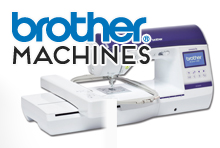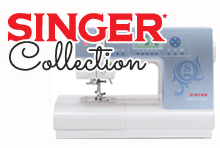
Checking stitching
Once you have threaded your machine, test the stitch to ensure it is working perfectly. It is a good idea to do some test stitching every time you change your stitch selection.






-
Choose a stitch from the diagrams on your machine and turn the dial to the correct setting.
-
Choose a stitch length and turn the dial. For most stitching, 2.2mm–2.5mm (13 stitches per inch) is a good choice.
-
It is best to leave the tension setting on your machine alone. On this machine, a line shows on the dial when it is set to the right tension for most stitching. Beyond that line in either direction, you are loosening or tightening the tension.
-
Place the fabric under the presser foot, using the right edge or the markings on the throat plate as a guide. These markings denote the distance from the needle when it is in its automatic default position. Arrange your fabric accordingly. Hold the threads at the rear, put the presser foot down and turn the balance wheel to lower the needle. Holding the thread tails in your left hand, start stitching. Guide the fabric through with both hands, neither pulling nor pushing it.
-
To reverse the direction of the stitching, to secure a seam, push down the reverse button, hold it down and go back two or three stitches. Release the button and continue forwards as required.
-
To finish a line of stitching, turn the balance wheel by hand to raise the needle, raise the presser foot, pull out the fabric and trim the thread ends very close to the stitching.
-
The stitching on the left has come out wrong. This could mean that the machine was not threaded properly, or that the bobbin is the the wrong way up.
-
This shows the stitching as it should come out: the top pink thread on the top of the fabric and the yellow bobbin thread showing on the back.
 All sewn up!
All sewn up!
If something is wrong with the stitching, try rethreading the machine rather than changing the tension as it is more likely to be a problem with the threading.
Get the book
For how essential how-tos, take a look at The Very Easy Guide To Using Your Sewing Machine by Wendy Gardiner (£12.99, Search Press).
 Retro Mixtape Cushion
Retro Mixtape Cushion
 Flossie Flamingo Softie Toy Sewing Pattern
Flossie Flamingo Softie Toy Sewing Pattern
 Dave Dachshund
Dave Dachshund
 Sewing Bee Shift Dress
Sewing Bee Shift Dress
 Nigel the Dragon Plushie Toy Sewing Pattern
Nigel the Dragon Plushie Toy Sewing Pattern
 Floaty Floral Three Quarter Sleeved Dress
Floaty Floral Three Quarter Sleeved Dress
 Sewing Bee Sleeveless Shell Top
Sewing Bee Sleeveless Shell Top
 Cat Softie Toy With Sleeping Bag Sewing Pattern
Cat Softie Toy With Sleeping Bag Sewing Pattern
 Arabella Blouse
Arabella Blouse
 Vintage-Style Memory Teddy Bear Sewing Pattern
Vintage-Style Memory Teddy Bear Sewing Pattern
 Easy Roger Reindeer Christmas Sewing Pattern
Easy Roger Reindeer Christmas Sewing Pattern
 Origami Fabric Boxes
Origami Fabric Boxes
 Child’s Storage Chair Tidy Sewing Pattern
Child’s Storage Chair Tidy Sewing Pattern
 Easy Kids’ Piggy Purse Sewing Pattern
Easy Kids’ Piggy Purse Sewing Pattern
 Embroidered Make-up Pouch Sewing Pattern
Embroidered Make-up Pouch Sewing Pattern
 Motivational Wall Hanging Sewing Pattern
Motivational Wall Hanging Sewing Pattern
 Simple Daisy Keyring Sewing Pattern
Simple Daisy Keyring Sewing Pattern
 Knitting Project Storage Bag Sewing Pattern
Knitting Project Storage Bag Sewing Pattern
 Violet the Victorious Doll: Superhero Sewing Pattern Part 2
Violet the Victorious Doll: Superhero Sewing Pattern Part 2
 Overnight Bag Template: The Crafts Channel
Overnight Bag Template: The Crafts Channel
 Simple Teepee Bag Template: The Crafts Channel
Simple Teepee Bag Template: The Crafts Channel
 Astrology Embroidery Hoops Sewing Pattern
Astrology Embroidery Hoops Sewing Pattern
 Handstitched toy labels
Handstitched toy labels
 Classic Polka Dot Dress Sewing Pattern
Classic Polka Dot Dress Sewing Pattern













